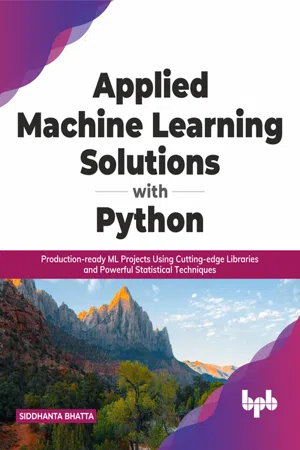
Applied Machine Learning Solutions with Python
Production-ready ML Projects Using Cutting-edge Libraries and Powerful Statistical Techniques (English Edition)
Siddhanta Bhatta
- English
- ePUB (adapté aux mobiles)
- Disponible sur iOS et Android
Applied Machine Learning Solutions with Python
Production-ready ML Projects Using Cutting-edge Libraries and Powerful Statistical Techniques (English Edition)
Siddhanta Bhatta
À propos de ce livre
A problem-focused guide for tackling industrial machine learning issues with methods and frameworks chosen by experts.
Key Features
? Popular techniques for problem formulation, data collection, and data cleaning in machine learning.
? Comprehensive and useful machine learning tools such as MLFlow, Streamlit, and many more.
? Covers numerous machine learning libraries, including Tensorflow, FastAI, Scikit-Learn, Pandas, and Numpy.
Description
This book discusses how to apply machine learning to real-world problems by utilizing real-world data. In this book, you will investigate data sources, become acquainted with data pipelines, and practice how machine learning works through numerous examples and case studies.The book begins with high-level concepts and implementation (with code!) and progresses towards the real-world of ML systems. It briefly discusses various concepts of Statistics and Linear Algebra. You will learn how to formulate a problem, collect data, build a model, and tune it. You will learn about use cases for data analytics, computer vision, and natural language processing. You will also explore nonlinear architecture, thus enabling you to build models with multiple inputs and outputs. You will get trained on creating a machine learning profile, various machine learning libraries, Statistics, and FAST API.Throughout the book, you will use Python to experiment with machine learning libraries such as Tensorflow, Scikit-learn, Spacy, and FastAI. The book will help train our models on both Kaggle and our datasets.
What you will learn
? Construct a machine learning problem, evaluate the feasibility, and gather and clean data.
? Learn to explore data first, select, and train machine learning models.
? Fine-tune the chosen model, deploy, and monitor it in production.
? Discover popular models for data analytics, computer vision, and Natural Language Processing.
Who this book is for
This book caters to beginners in machine learning, software engineers, and students who want to gain a good understanding of machine learning concepts and create production-ready ML systems. This book assumes you have a beginner-level understanding of Python.
Table of Contents
1. Introduction to Machine Learning
2. Problem Formulation in Machine Learning
3. Data Acquisition and Cleaning
4. Exploratory Data Analysis
5. Model Building and Tuning
6. Taking Our Model into Production
7. Data Analytics Use Case
8. Building a Custom Image Classifier from Scratch
9. Building a News Summarization App Using Transformers
10. Multiple Inputs and Multiple Output Models
11. Contributing to the Community
12. Creating Your Project
13. Crash Course in Numpy, Matplotlib, and Pandas
14. Crash Course in Linear Algebra and Statistics
15. Crash Course in FastAPI
About the Authors
Siddhanta Bhatta is a Machine Learning engineer with 6 years of experience in building machine learning products. He is currently working as a Senior Software Engineer in Data Analytics, Machine Learning, and Deep Learning. He has built multiple data apps in various domains such as vision, NLP, Data Analytics, and many more. He is a Microsoft-certified data scientist who believes in data literacy. LinkedIn Profile: https://www.linkedin.com/in/siddhanta-bhatta-377880a7/
Blog Link: https://joyofunderstanding926957091.wordpress.com/
Foire aux questions
Informations
CHAPTER 1
Introduction to Machine Learning
Structure
- What is machine learning?
- Some machine learning jargons
- Machine learning definitions
- Why should we use it?
- Types of machine learning
- How much do I need to know to do machine learning?
Objective
- Understand what machine learning is
- Get familiar with some machine learning jargons
- Understand the importance of machine learning in the current time
1.1 What is machine learning?
- We are given a problem. We want to output and are given some constraints.
- Then, we think about taking the input and writing rules to get the output (keeping the constraints satisfied).
- Then, we test our code, find errors, modify our rules, or update the understanding of the problem. In some problems, we change the problem a bit or add new inputs. Thus, it is a flexible approach.




1.2 Some machine learning jargons
1.3 Machine learning definition
Table des matières
- Cover Page
- Title Page
- Copyright Page
- Dedication Page
- About the Author
- About the Reviewers
- Acknowledgement
- Preface
- Errata
- Table of Contents
- 1. Introduction to Machine Learning
- 2. Problem Formulation in Machine Learning
- 3. Data Acquisition and Cleaning
- 4. Exploratory Data Analysis
- 5. Model Building and Tuning
- 6. Taking Models into Production
- 7. Data Analytics Use Case
- 8. Building a Custom Image Classifier from Scratch
- 9. Building a News Summarization App Using Transformers
- 10. Multiple Inputs and Multiple Output Models
- 11. Contributing to the Community
- 12. Creating Your Own Project
- 13. Crash Course in Numpy, Matplotlib, and Pandas
- 14. Crash Course in Linear Algebra and Statistics
- 15. Crash Course in FastAPI
- Index